动词-ing形式作主语和宾语
- 格式:docx
- 大小:22.23 KB
- 文档页数:6
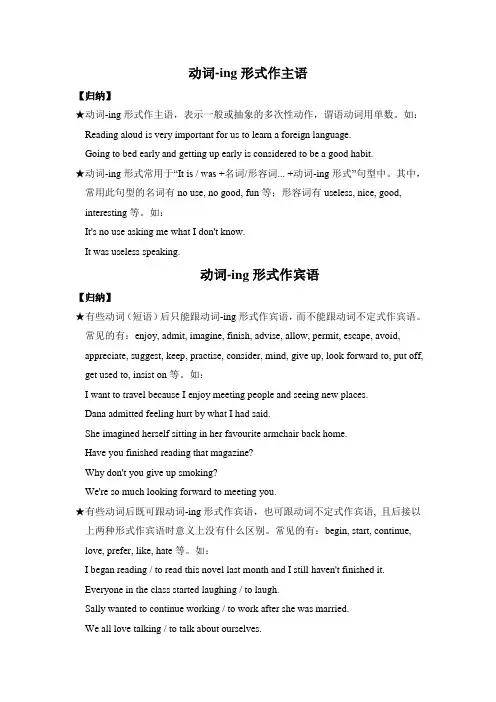
动词-ing形式作主语【归纳】★动词-ing形式作主语,表示一般或抽象的多次性动作,谓语动词用单数。
如:Reading aloud is very important for us to learn a foreign language.Going to bed early and getting up early is considered to be a good habit.★动词-ing形式常用于“It is / was +名词/形容词... +动词-ing形式”句型中。
其中,常用此句型的名词有no use, no good, fun等;形容词有useless, nice, good, interesting等。
如:It's no use asking me what I don't know.It was useless speaking.动词-ing形式作宾语【归纳】★有些动词(短语)后只能跟动词-ing形式作宾语,而不能跟动词不定式作宾语。
常见的有:enjoy, admit, imagine, finish, advise, allow, permit, escape, avoid, appreciate, suggest, keep, practise, consider, mind, give up, look forward to, put off, get used to, insist on等。
如:I want to travel because I enjoy meeting people and seeing new places.Dana admitted feeling hurt by what I had said.She imagined herself sitting in her favourite armchair back home.Have you finished reading that magazine?Why don't you give up smoking?We're so much looking forward to meeting you.★有些动词后既可跟动词-ing形式作宾语,也可跟动词不定式作宾语, 且后接以上两种形式作宾语时意义上没有什么区别。
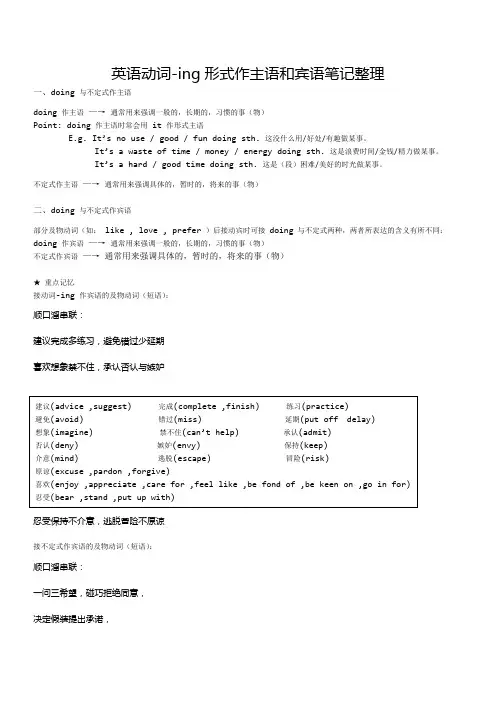
英语动词-ing形式作主语和宾语笔记整理一、doing与不定式作主语doing作主语—→通常用来强调一般的,长期的,习惯的事(物)Point: doing 作主语时常会用 it 作形式主语E.g. It’s no use / good / fun doing sth. 这没什么用/好处/有趣做某事。
It’s a waste of time / money / energy doing sth. 这是浪费时间/金钱/精力做某事。
It’s a hard / good time doing sth. 这是(段)困难/美好的时光做某事。
不定式作主语—→通常用来强调具体的,暂时的,将来的事(物)二、doing与不定式作宾语部分及物动词(如:like , love , prefer)后接动宾时可接doing与不定式两种,两者所表达的含义有所不同:doing作宾语—→通常用来强调一般的,长期的,习惯的事(物)不定式作宾语—→通常用来强调具体的,暂时的,将来的事(物)★重点记忆接动词-ing作宾语的及物动词(短语):顺口溜串联:建议完成多练习,避免错过少延期喜欢想象禁不住,承认否认与嫉妒忍受保持不介意,逃脱冒险不原谅接不定式作宾语的及物动词(短语):顺口溜串联:一问三希望,碰巧拒绝同意,决定假装提出承诺,渴望设法买得起,计划准备不失败。
接动词-ing / 不定式作宾语的及物动词:①动词love , like , hate等后跟动名词和不定式作宾语,但接动名词表示经常性的情况,接不定式表示具体的动作②动词begin , start , continue等后既可跟不定式,又可以跟动-ing形式宾语,意义基本相同③一些动词后既可跟动名词做宾语又可以跟不定式作宾语,但意义上有很大差别:三、动名词逻辑主语以及其他问题①动名词作主语时,形容词性物主代词one’s与名词所有格前置作动名词的逻辑主语,具体形式为:one’s doing②动名词作宾语时,由形容词性物主代词one’s,人称宾格与名词所有格作动名词的逻辑主语,具体形式为:vt. One’s doing③逻辑主语位于非谓语动词的最前面:E.g. his not being late.④动词-ing的肯定形式:一般时:主动:doing 被动:being done完成时:主动:having done 被动:having been done⑤动词-ing的否定形式:not + 动词-ingnot + having done not having been done(注意:not 一定位于肯定形式的最前面)⑥在need , want , require 等动词后接动名词,即用主动形式表示被动意义:need/want/require doing = need/want/require to be done。
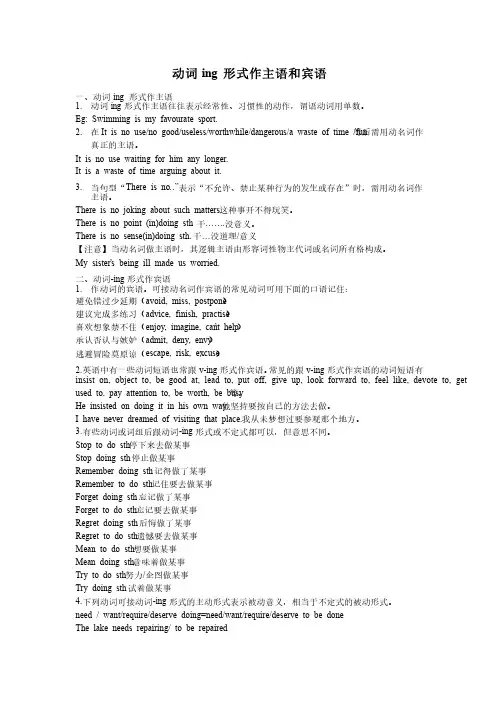
动词ing 形式作主语和宾语形式作主语一、动词ing 形式作主语1.动词ing形式作主语往往表示经常性、习惯性的动作,谓语动词用单数。
形式作主语往往表示经常性、习惯性的动作,谓语动词用单数。
Eg: Swimming is my favourate sport. 2.在It is no use/no good/useless/worthwhile/dangerous/a waste of time /fun等后需用动名词作真正的主语。
真正的主语。
It is no use waiting for him any longer. It is a waste of time arguing about it. …”表示“不允许、禁止某种行为的发生或存在”时,需用动名词作3.当句型“There is no…”主语。
主语。
There is no joking about such matters. 这种事开不得玩笑。
这种事开不得玩笑。
……..没意义。
There is no point (in)doing sth 干……没意义。
There is no sense(in)doing sth. 干…没道理/意义意义【注意】当动名词做主语时,其逻辑主语由形容词性物主代词或名词所有格构成。
【注意】当动名词做主语时,其逻辑主语由形容词性物主代词或名词所有格构成。
My sister’s being ill made us worried. 形式作宾语二、动词-ing形式作宾语1.作动词的宾语。
可接动名词作宾语的常见动词可用下面的口语记住:作动词的宾语。
可接动名词作宾语的常见动词可用下面的口语记住:避免错过少延期(avoid, miss, postpone)建议完成多练习(advice, finish, practise)喜欢想象禁不住(enjoy, imagine, can’t help)承认否认与嫉妒(admit, deny, envy)逃避冒险莫原谅(escape, risk, excuse)2.英语中有一些动词短语也常跟v-ing形式作宾语。

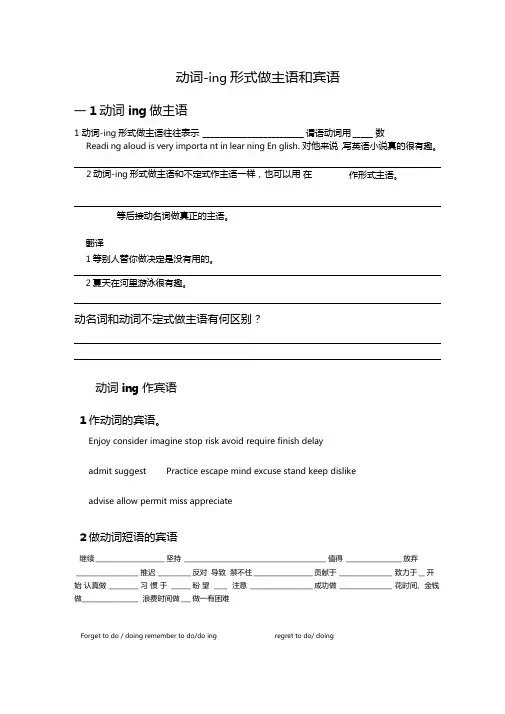
动词-ing形式做主语和宾语一1动词ing做主语1 动词-ing形式做主语往往表示_________________________ 谓语动词用 _____ 数Readi ng aloud is very importa nt in lear ning En glish. 对他来说,写英语小说真的很有趣。
动词ing作宾语1作动词的宾语。
Enjoy consider imagine stop risk avoid require finish delayadmit suggest Practice escape mind excuse stand keep dislikeadvise allow permit miss appreciate2做动词短语的宾语继续_____________________ 坚持___________________________________________ 值得_________________ 放弃___________________ 推迟__________ 反对导致禁不住 __________________ 贡献于________________ 致力于__ 开始认真做 _________ 习惯于 ______ 盼望 ____ 注意___________________ 成功做 ________________ 花时间、金钱做_________________ 浪费时间做 ___ 做一有困难Forget to do / doing remember to do/do ing regret to do/ doing3写出汉意Forget to do / doing remember to do/do ing regret to do/ doingStop to do /doing4 n eed/require/ want doing/to be done翻译窗户需要擦了。


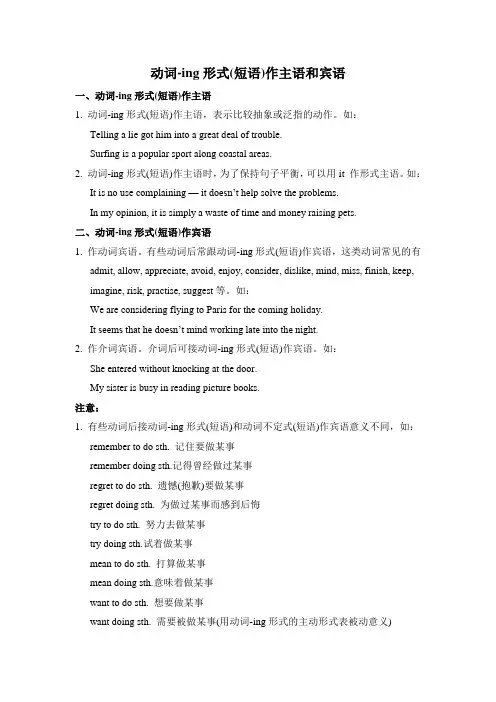
动词-ing形式(短语)作主语和宾语一、动词-ing形式(短语)作主语1. 动词-ing形式(短语)作主语,表示比较抽象或泛指的动作。
如:Telling a lie got him into a great deal of trouble.Surfing is a popular sport along coastal areas.2. 动词-ing形式(短语)作主语时,为了保持句子平衡,可以用it 作形式主语。
如:It is no use complaining —it doesn’t he lp solve the problems.In my opinion, it is simply a waste of time and money raising pets.二、动词-ing形式(短语)作宾语1. 作动词宾语。
有些动词后常跟动词-ing形式(短语)作宾语,这类动词常见的有admit, allow, appreciate, avoid, enjoy, consider, dislike, mind, miss, finish, keep, imagine, risk, practise, suggest等。
如:We are considering flying to Paris for the coming holiday.It seems that he doesn’t mind working late into the night.2. 作介词宾语。
介词后可接动词-ing形式(短语)作宾语。
如:She entered without knocking at the door.My sister is busy in reading picture books.注意:1. 有些动词后接动词-ing形式(短语)和动词不定式(短语)作宾语意义不同,如:remember to do sth. 记住要做某事remember doing sth.记得曾经做过某事regret to do sth. 遗憾(抱歉)要做某事regret doing sth. 为做过某事而感到后悔try to do sth. 努力去做某事try doing sth.试着做某事mean to do sth. 打算做某事mean doing sth.意味着做某事want to do sth. 想要做某事want doing sth. 需要被做某事(用动词-ing形式的主动形式表被动意义)2. 在动词-ing形式(短语)前面可以加上其逻辑主语来强调动作的执行者,该逻辑主语常为形容词性物主代词或名词所有格。
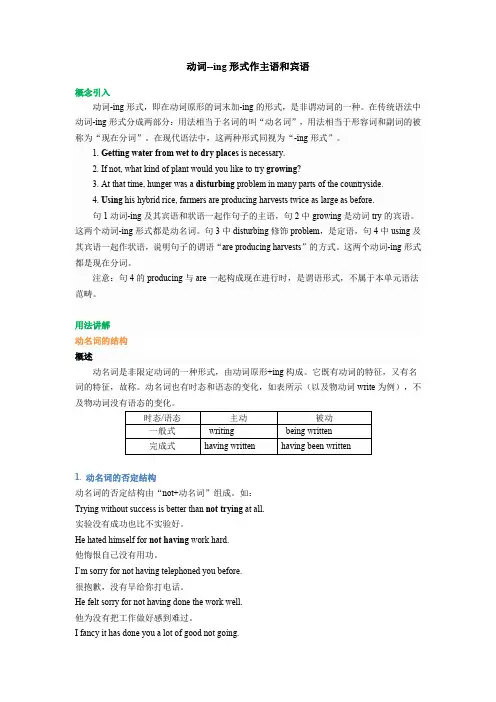
动词--ing形式作主语和宾语概念引入动词-ing形式,即在动词原形的词末加-ing的形式,是非谓动词的一种。
在传统语法中动词-ing形式分成两部分:用法相当于名词的叫“动名词”,用法相当于形容词和副词的被称为“现在分词”。
在现代语法中,这两种形式同视为“-ing形式”。
1. Getting water from wet to dry places is necessary.2. If not, what kind of plant would you like to try growing?3. At that time, hunger was a disturbing problem in many parts of the countryside.4. Using his hybrid rice, farmers are producing harvests twice as large as before.句1动词-ing及其宾语和状语一起作句子的主语,句2中growing是动词try的宾语。
这两个动词-ing形式都是动名词。
句3中disturbing修饰problem,是定语,句4中using及其宾语一起作状语,说明句子的谓语“are producing harvests”的方式。
这两个动词-ing形式都是现在分词。
注意:句4的producing与are一起构成现在进行时,是谓语形式,不属于本单元语法范畴。
用法讲解动名词的结构概述动名词是非限定动词的一种形式,由动词原形+ing构成。
它既有动词的特征,又有名词的特征,故称。
动名词也有时态和语态的变化,如表所示(以及物动词write为例),不及物动词没有语态的变化。
1. 动名词的否定结构动名词的否定结构由“not+动名词”组成。
如:Trying without success is better than not trying at all.实验没有成功也比不实验好。

动词-ing形式的用法在句子中的位置动词-ing形式是英语中常见的一种形式,它可以用作动词、名词、形容词或副词。
在句子中,动词-ing形式的用法位置有以下几种情况:1. 作主语:动词-ing形式可以作为主语出现在句子中。
例如:作主语:动词-ing形式可以作为主语出现在句子中。
例如:- Swimming is my favorite sport.(游泳是我最喜欢的运动。
)- Dancing helps me relax.(跳舞帮助我放松。
)2. 作宾语:动词-ing形式可以作为及物动词的宾语。
例如:作宾语:动词-ing形式可以作为及物动词的宾语。
例如:- I enjoy reading books.(我喜欢读书。
)- She hates doing homework.(她讨厌做作业。
)3. 作表语:动词-ing形式可以作为表语出现在句子中,表示主语的状态或特征。
例如:作表语:动词-ing形式可以作为表语出现在句子中,表示主语的状态或特征。
例如:- His favorite activity is playing soccer.(他最喜欢的活动是踢足球。
)- The most interesting thing about him is his singing ability.(关于他最有趣的事情就是他的唱歌能力。
)4. 作定语:动词-ing形式可以作为定语修饰名词或代词。
例如:作定语:动词-ing形式可以作为定语修饰名词或代词。
例如:- The running water is very clear.(流动的水非常清澈。
)- She bought a loving gift for her mother.(她给妈妈买了一个充满爱意的礼物。
)5. 作状语:动词-ing形式可以作为状语修饰动词、形容词或副词,表示时间、原因、条件等。
例如:作状语:动词-ing形式可以作为状语修饰动词、形容词或副词,表示时间、原因、条件等。
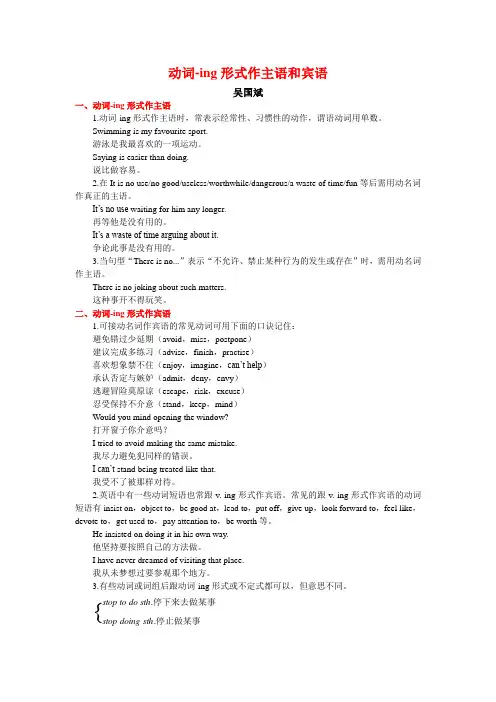
动词-ing 形式作主语和宾语吴国斌一、动词-ing 形式作主语1.动词-ing 形式作主语时,常表示经常性、习惯性的动作,谓语动词用单数。
Swimming is my favourite sport.游泳是我最喜欢的一项运动。
Saying is easier than doing.说比做容易。
2.在It is no use/no good/useless/worthwhile/dangerous/a waste of time/fun 等后需用动名词作真正的主语。
It’s no use waiting for him any longer.再等他是没有用的。
It’s a waste of time arguing about it.争论此事是没有用的。
3.当句型“There is no...”表示“不允许、禁止某种行为的发生或存在”时,需用动名词作主语。
There is no joking about such matters.这种事开不得玩笑。
二、动词-ing 形式作宾语1.可接动名词作宾语的常见动词可用下面的口诀记住:避免错过少延期(avoid ,miss ,postpone )建议完成多练习(advise ,finish ,practise )喜欢想象禁不住(enjoy ,imagine ,can’t help )承认否定与嫉妒(admit ,deny ,envy )逃避冒险莫原谅(escape ,risk ,excuse )忍受保持不介意(stand ,keep ,mind )Would you mind opening the window?打开窗子你介意吗?I tried to avoid making the same mistake.我尽力避免犯同样的错误。
I can’t stand being treated like that.我受不了被那样对待。
2.英语中有一些动词短语也常跟v.-ing 形式作宾语。
动词+ing形式的用法动词的 -ing形式是动词的一种非谓语形式,由动词原形加 -ing构成,可以在句子中用作主语、宾语、表语、宾语补语、状语和定语。
一、动词-ing形式作主语动词-ing形式作主语常用来表示经常性或习惯性的动作。
如:Coming to Hangzhou by train takes about 16 hours.Swimming is the best sport in summer.Seeing is believing.注:有时,为了使句子保持平衡,可以用it作形式主语。
如:It’s nice talking with you.It’s a waste of time arguing with such a woman.二、动词-ing形式作宾语动词-ing形式既可作动词、短语动词的宾语,又可作介词的宾语。
1. 以下动词或短语需接动词-ing形式作宾语:admit, avoid, appreciate, consider, enjoy, finish, keep, mind, suggest等动词;dream of, feel like, give up, keep on, prefer… to, succeed in, think of等短语。
2. 在下列短语中,to是介词,后面应该用动词-ing形式作宾语:be / get used to, look forward to, devote … to, pay attention to等。
3. 有些动词既可能带-ing分词作宾语,也可以带to不定式作宾语,但在语义上却有很大的差别。
forget doing 忘记做过某事;forget to do 忘记要做某事remember doing 记得做过某事;remember to do 记住要做某事stop to do 停下来去做某事;stop doing 停止做某事mean doing 意味着做;mean to do 打算做try to do 努力做某事;try doing 试一试做某事regret doing 后悔做了某事;regret to do 遗憾要做某事can’t help doing 禁不住做;can’t help (to) do不能帮忙做chance to do 碰巧去做某事;chance doing 冒险试一试做某事go on to do 接着又做另一件事;go on doing 继续做同一件事4. 在allow, advise, permit等动词后直接跟动词-ing形式作宾语,如果这些词后面有名词或代词作宾语,其后要用动词不定式作宾语补足语。
动词-ing形式作主语和宾语一、动词-ing形式作主语1、动词-ing形式做主语时,常表示一般或抽象的经常性、习惯性的动作,谓语动词用单数。
Eg:Swimming is my favourite sport..Saying is easier than doing.2、在It is no use/no good/fun/a waste of time/useless等句型中,用it作形式主语放在句首,真正的主语用动词-ing形式放在句末。
Eg:It’s no use waiting for him any longer.It’s a waste of time arguing about it..二、动词-ing形式作宾语1、有些动词后面要跟动名词作宾语。
可用以下口诀记住:避免错过少延期(aviod,miss,postpone)建议完成多练习(advise,finish,practise)喜欢想象禁不住(enjoy,imagine,can’t help)承认否定与嫉妒(admit,deny,envy)逃避冒险莫原谅(escape,risk,excuse)忍受保存不介意(stand,keep,mind)Eg:Will you admie having broken the window?Would you mind turning down your radio a little?The squirrel was luckly that it just missed being caught.注意:某些以to结尾的动词短语也必须接动词-ing形式做宾语,常见的有:Devote oneself to(投入……),get down to(着手干……),lead to(通向,导致),object to(反对),pay attention to(注意),look forward to(盼望),be used to(习惯于),stick to(坚持)等。
Part Ⅱ Grammar ——动词-ing 形式作主语和宾语[思维导图]一、概念动词-ing 形式是动词的一种非谓语形式,包括现在分词和动名词两种。
1.动词-ing 形式的时态和语态2.动词-ing 动名词在句中作主语、宾语、表语和定语;现在分词在句中作状语、宾语补足语和定语。
二、动词-ing 形式作主语1.动词-ing 形式直接作主语表示抽象的概念,通常直接置于句首,谓语动词用单数形式。
Reading aloud is a good way in learning a language.朗读是学习语言的一个好办法。
Getting up early is a good habit.早起是一种好习惯。
2.置于句末,用it 作形式主语,多见于下面几个句型:It is worth doing...做……是值得的It +be +a waste of time doing...做……是浪费时间的It is/was no good/use doing...做……是没有用的It is a waste of time talking about such useless things.谈论这些没用的事情是在浪费时间。
It is no use crying over spilt milk.覆水难收。
三、动词-ing 形式作宾语的用法1.有些动词和动词短语后常用动词-ing 形式作宾语。
如admit ,appreciate ,avoid ,stand(忍受),consider ,delay ,dislike ,enjoy ,imagine ,escape ,excuse ,suggest ,feel like ,finish ,forgive ,mention ,mind ,miss ,practise ,get down to ,give up ,devote...to ,insist on ,keep(on),look forward to ,pay attention to ,put off ,stick to ,be accustomed to =be used to(习惯于)等等。
一、动词-ing形式作主语和宾语
考点一:
动词-ing形式的基本用法
动词-ing具有名词的性质,可在句中担当主语、宾语、标语、定语、宾语补足语和状语,
动词-ing形式作主语常用来表示经常性和习惯性的动作。
动词-ing形式作主语通常放在句首。
但不能单独做谓语。
考点二:
动词-ing做主语的用法:
1)动词-ing作主语时,往往表示习惯性、经常性的动作,在口语中也表示具体的动作。
如:
Paiting is his hobby.
2)动词-ing形式作主语和不定式作主语一样,也可以用it做形式主语,但不定式作主语往往表示具体的特别是将来的动作。
如:
It is no use talking without doing.
光说不做是没用的
It is so hot. what I want to do now is to have a swim in a river.天这么热,现在我想做的事情就是在河里游泳。
动词-ing形式作主语时,为了保持句子平衡,可以用it作形式主语。
常用的结构:
1. It is + no use / no good / useless etc.+ v-ing
2. It is + nice / good / interesting / a waste of…etc. + v-ing例如:
It is no use crying over spilt milk.事考点三:
动词-ing形式作宾语的用法
1.有些动词或动词短语常用动词-ing形式作宾语:
admit,avoid,appreciate,consider,enjoy,escape,finish,keep,mind, miss, suggest等动词; can’t stand, give up, feel like, keepon, think of, set about, dream of等短语。
避免错过少延期
建议完成多练习
喜欢想象禁不住
承认否定与嫉妒
逃避冒险xxxx
忍受保持不介意
考虑欣赏还愿意
2.在下列短语中,to是介词,后面应用动词-ing形式作宾语:
be / get us ed to, look forward to, devote…to, pay attention to,object to等。
3。
有些句子结构省略介词in,由doing做宾语
3.下列动词或短语既可以跟动词-ing形式作宾语,也可以跟不定式作宾语,但意义上有区别:
●like, love, prefer如表示经常性的行为后接动词-ing形式;如表示具体的行为常用动词不定式,但要注意:
如果like, love,prefer前有would,后面则接动词不定式。
如:
Would you liketo go shopping with me
●下列几组词接动词-ing形式作宾语和不定式作宾语含义不同:
forget doing忘记已做过某事;forget to do忘记要做某事rember doing记得做过某事;rember todo记住要做某事
mean doing意思是,意味着;mean to do打算做regret doing后悔做过某事;regret to do遗憾要做某事can’t help doing禁不住做;can’t help (to) do不能帮忙做。
●在allow, permit, forbid,advise,等动词后直接跟动词-ing形式作宾语,如果这些词后面有名词或代词作宾语,其后要用动词不定式作宾语补足语。
如:
We don’t allow smoking in the classroom.
We don’t allow students to smoke.
●动词need,require,want作“需要”解时,其后用动词-ing
的主动形式或不定式的被动形式作宾语,这时动词-ing的主动形式表被动意义。
如:
Your coat wants washing. = Your coat wants to be washed.
三、动词-ing的复合结构
动词-ing的复合结构即:
物主代词或名词所有格(作宾语时也可以用代词宾格或名词普通格) +动词-ing。
如:
Lucy’s turning up surprised everyone present.
Would you mind my / me using your mobile phone?
四、动词-ing的时态、语态以及否定形式动词-ing有一般式(doing)和完成式(having done)两种时态,一般式的被动语态是being done,完成式的被动语态是having been done。
动词-ing的完成式所表示的动作发生在谓语动词的动作之前。
动词-ing的否定形式是在doing之前加not。
例如:
I’m sorry for not having told you the news earlier.
【巩固练习】
单项填空。
1. The suggestion they all objected to ____ very effective finally.
A. proved
B. proving
C. prove
D.、o prove
2. It’s necessary to be prepared for a job interview. ____ the answers ready will be of great help.
A. To have had
B. Having had
C. [Have
D. Having
3.—What made you so happy?
—____ the first prize.
A. Get
B. Getting
C. Got
D. To get
4. I really appreciate ____ a great effort to help me out of the trouble.
A. you to take
C. your taking
D. your being taken
5. I still rember ____ to see films in the open air when I was small.
A. to take
B. taking
C. being taken
D. to be taken
6. As a result of the serious flood, two-thirds of the buildings in the area ____.
A. need repairing
B. needs to repair
C. needs repairing
D. need to repair
7.—You did very well at the meeting, Black.
—Well, I regret ____ that to the boss.
A. say
B. to say
C. said
D. having said
8. It is worth considering whatmakes ”convenience” foods so popular, and ____ better ones of yourown.
A. introduces
C. introducing
D. introduced Key:
1–4 ADBC5–8 CADC。